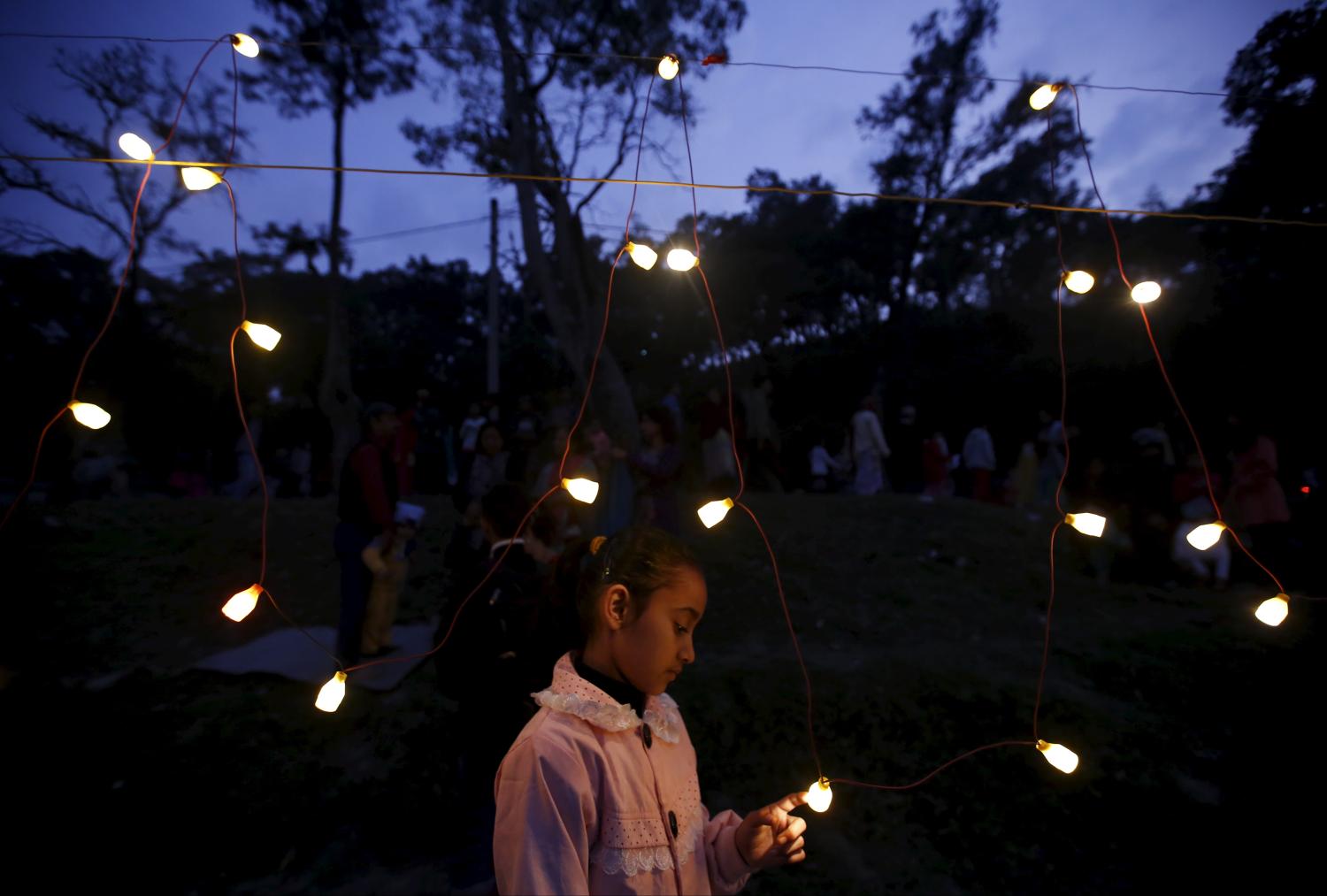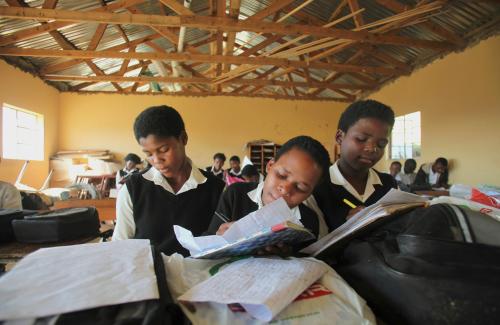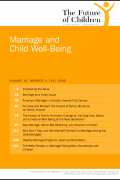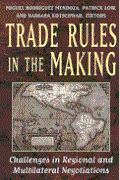The year 2014 holds yet another chance to eliminate the harmful traditional practice of child marriage in a long struggle that has consumed the attention of gender activists, public health practitioners and human rights advocates over the past 50 years.
As youth employment fails to keep pace with the continent’s teeming population growth rates and as rural economies collapse in the face of armed conflict and climate displacement, the problem of what to do with the girls of Africa is of central concern to the poor village man as it is for the global community troubled by human security. The United Nations Population Fund (UNFPA) estimates that if current population growth trends continue, one in four adolescent girls will be in sub-Saharan Africa by 2030, and that the total number of adolescent mothers in this zone will increase from 10.1 million in 2010 to 16.4 million in 2030. Most of Africa’s adolescent mothers are child brides married before the age of 18 years—the age of maturity, designated in United Nations Conventions such as the Convention of the Rights of the Child and the Convention on the Elimination of All Forms of Discrimination Against Women. Child marriage, often referred to as forced or early marriage, is a formal marriage or an informal union taking place in the shadows of society—as it is underreported and largely practiced under customary and religious laws.
Child marriage is shaped by custom, religion and poverty and exacerbated by ethno-religious crisis, conflict and environmental disasters. Girls are denied the right to education, made to toil in domestic servitude and live in physical seclusion in their husbands’ marital homes. Child brides everywhere are disempowered, vulnerable and exploited. Implications go behind the well-being of the child: Child marriage negatively impacts socio-economic development of regions and nations as well as global stability. Gordon Brown, in a 2013 review of child marriage, observes that infants born to child mothers under the age of 18 are 60 percent more likely to die in the first year of life than infants born to mothers 19 years and older. World Bank studies by Nguyen and Wodon (2012) note that for each year of early marriage, the probability of literacy for the girl is reduced by 5.6 percentage points, and the probability of secondary school completion declines by 6.5 percentage points. In Africa, where the median age of marriage is younger, girls have even less access to educational, family planning and obstetric care services. In addition, the millions of girls in Africa who marry before age 18 are more likely to have few or no years of schooling, reside in poorer and rural areas, be victims of physical or sexual violence, have their right to free movement restricted, and be denied access to health and social services.
Although the practice is on the decline worldwide and in North Africa in particular, in sub-Saharan Africa child marriage continues to be a dominant form of customary unions as the options of school and youth employment remain unattainable in the largely agrarian economies of this region. While the absolute numbers and prevalence of child marriages are highest in South Asia, many experts agree that the intensity, pattern and context of child marriage in sub-Saharan Africa in general and West Africa in particular make this phenomenon most severe and detrimental to the lives of girls. The mean spousal age difference between husband and wife is 5 years more in West Africa compared to East and Southern Asia, the age of first pregnancies and total number of adolescent pregnancies are also higher in Africa compared to Asia and access and uptake of family planning services is also lower in the this region.
Four of the 10 countries with the highest rates of child marriage worldwide are in West Africa. Three of these countries—Niger (75 percent), Guinea (63 per cent) and Mali (55 percent)—have maintained their top spots for over 10 years. In addition, in the Central African Republic, Mozambique, South Sudan, Malawi and the Democratic Republic of the Congo, more than 50 percent of girls are in a marital union before the age of 18 years.
Ending child marriage is a global good. It can lessen the burden on countries’ health infrastructure and mitigate the human footprint of resource-poor countries in Africa. It reduces human suffering, recognizes human dignity and challenges gender-based discrimination. Ultimately, ending child marriage frees up untapped human resources and enables girls and women to contribute meaningfully to development.
Despite numerous initiatives by activists and the global development community, child marriage has failed to go away in many hotspots of the global South it remains as persistent as in the pre-independence era. In West Africa—the region identified in Gordon Brown’s 2013 review as having the highest incidences of child marriage worldwide—a recent Ford Foundation report found that the median age of first marriage had only increased by a little over one year between 2000 and 2012. Explanations for the persistence of child marriage in Africa revolve around the gender blindness of male policymakers; weakness of child protection and human rights agencies; and the persistence of culture and tradition in the context of state fragility. Against this background, pushing through an ending child marriage policy agenda is a difficult and uphill struggle. Since 2014 is no ordinary year, but one in which the global development priorities are being set for the post-2015 sustainable development era, now is the opportunity to create policies and goals to eliminate this harmful practice within the global framework while taking into account the local needs of the man and woman in the village.
What has and hasn’t been done to end child marriage in Africa?
As Africa lays out the continent’s development objectives for the post-2015 period, high-level consultations at the African Union has resulted in the African Consensus Position Document with three clear policy objectives. However, none of the development priorities focus intently on gender equality or ending child marriage. Rather, gender equality only emerges as one of eight targets within the third development priority (the human development priority), and it links the eradication of female genital mutilation (FGM) with ending child marriage. A recent publication by the Brookings Institution on child marriage in West Africa suggests that such a linkage hinders and complicates the cause of ending child marriage for policymakers. Moreover, the target of eradicating FGM and child marriage is proposed without reference to social justice for violation of the myriad child marriage laws that exist, and no operationalized plan is put forward to for building support for this initiative at the grassroots level.
With limited attention accorded to ending child marriage and with regional economic agencies driving priority setting in Africa, there is a real and palpable fear that the target of ending child marriage may not be operationalized. Similarly, while many activists and civil society organizations across the continent have committed to ending child marriage, they find themselves significantly under resourced, circumscribed in their outreach base, limited in representation at global platforms and weak in their ability to utilize right and justice in the struggle.
African feminist associations have protested the limited attention accorded to female genital mutilation and ending child marriage in the African Consensus Position and have called for a standalone goal on gender equality and women’s empowerment with specific indicators around increasing the median age of marriage and a legislative framework guaranteeing justice for girls whose rights have been violated. The position advanced by feminist groups is a simple but convincing one—the continent’s crippling youth unemployment problem, skills deficit and overburdened infrastructure cannot be addressed if girls are denied schooling, are coerced into marriage before the age of consent, and are forced into motherhood in childhood.
Not surprisingly, recent commitments towards ending child marriage in Africa within the framework of the post-2015 agenda appear to be yet another attempt at laying out a wish list with little meaning for the people of the continent as efforts remain concentrated at the high level of regional institutions. Examples include the 6th February 2014 Outcome Document of the 58th session of the U.N. Commission on the Status of Women on the theme “Challenges and achievements in the implementation of the MDG for women and girls” and the 8th February 2014 Declaration of the African Union Ministers of Gender and Women’s Affairs on the Post-2015 Development Agenda. These documents are not backed up by a framework inspiring consultation from below and contain no mechanism for building commitment from men, women, and community and faith leaders at the grassroots level.
Empowering grassroots movements, ending child marriage and influencing the post-2015 development agenda
For Africa to achieve the seismic shift away from child marriage, more has to be done to join policy initiatives with grassroots concerns. At the policy level, the regions’ politicians and bureaucrats must translate high-level commitments into real, national-level policies, programs and projects linking the goal of ending child marriage with youth employment, adolescent reproductive health and education policies. Policymakers must also design and implement smart interventions that convince communities of the benefits of girls’ education by paying attention to quality and by linking education to income generation, skill acquisition and job creation for youth. It seems clear that robust, high-level initiatives may well fail to be effective if they do not provide an alternative model for communities making tough decisions about the future for girls in the face of insecurity, high youth unemployment, and low-quality but high-cost education.
The good news is that the global community shaping the post-2015 agenda is beginning to commit to ending child marriage as a development priority. The most recent campaign to end this harmful traditional practice, launched by the U.N. secretary-general at the inaugural International Day of the Girl Child, has been picked as illustrative goal 2 of the High-Level Panel and the UNFPA Proposal for the Post-2015 Development Framework called for an end to child marriage. However, the global community must do more to provide models, training, and platforms for action and inclusive debate around the goal of ending child marriage within the framework of a meaningful post-2015 sustainable development agenda in which girls and women are central.
The Brookings Institution is committed to quality, independence, and impact.
We are supported by a diverse array of funders. In line with our values and policies, each Brookings publication represents the sole views of its author(s).










Commentary
Ending Child Marriage Should be a Development Priority for Africa’s Grassroots in 2014
March 17, 2014